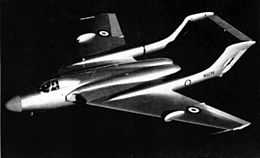1952 Farnborough Airshow DH.110 crash
|
The DH.110 prototype "WG236" | |
| Accident summary | |
|---|---|
| Date | 6 September 1952 |
| Summary | structural failure |
| Site |
Farnborough Airport Hampshire, England 51°16′33″N 000°46′35″W / 51.27583°N 0.77639°W |
| Crew | 2 |
| Injuries (non-fatal) | ~60 spectators |
| Fatalities | 31 |
| Survivors | 0 |
| Aircraft type | DH.110 |
| Operator | de Havilland |
| Registration | WG236 |
The 1952 Farnborough Airshow DH.110 crash was an air show accident involving a de Havilland DH.110 that killed 29 spectators, the pilot John Derry[1] and the onboard flight test observer Anthony Richards.[2] The DH.110, a prototype, was being demonstrated at the Farnborough Airshow when during a manoeuvre, the aircraft broke up. The cause was a faulty wing leading edge design. The DH.110 was grounded and strict safety procedures were subsequently enacted.
No member of the public has been killed at a British air show since.[3][lower-alpha 1] After modifications to the design the DH.110 entered service with the Royal Navy as the de Havilland Sea Vixen.
Crash
The planned demonstration of the DH.110 on that day was nearly cancelled when the aircraft at Farnborough, an all-black night fighter prototype, became unserviceable. It had been taken supersonic over the show on the opening day.[5] Derry and Richards left Farnborough to collect WG 236 and flew it from Hatfield to Farnborough with just enough time to start their slot.
Following a low-level supersonic flypast and during a left bank at about 450 knots (830 km/h) toward the air show's 120,000 spectators, the pilot started a climb. The outer starboard wing and, immediately afterward, the outer port wing broke off the aircraft; followed by both engines and the cockpit—the latter injuring several spectators.[6] One engine broke into two sections and "ploughed into ... Observation Hill", injuring and killing numerous other spectators.[6]
One eyewitness was Richard Gardner, then five years old. "I'll never forget, it looked like confetti, looked like silver confetti. The remaining airframe floated down right in front of us. It just came down like a leaf. And then the two engines, like two missiles, shot out of the airframe and hurtled in the direction of the airshow. There was a sort of silence, then people, one or two people screamed but mostly it was just a sort of shock. You could hear some people sort of whimpering which was quite shocking."[7]
Following the accident the air display programme continued once the debris was cleared from the runway, with Neville Duke exhibiting the prototype Hawker Hunter and taking it supersonic over the show later that day.
Aftermath
Both The Queen and Duncan Sandys, the Minister of Supply, sent messages of condolence, and jets at air shows were obliged to keep at least 230 m (750 ft) from crowds if flying straight and 450 m (1,480 ft) when performing manoeuvres and always at an altitude of at least 150 m (490 ft).[2] The coroner's jury recorded the deaths of Derry and Richards as "died accidentally in the normal course of their duty."
Of the spectators killed the jury recorded that "the deaths were accidental" adding that "no blame is attached to Mr. John Derry".[8] The accident report of 8 April 1953 stated the manoeuvring had caused an airframe instability because of a faulty D-nose leading edge arrangement (which had successfully been used in the lighter subsonic de Havilland Vampire). The redesigned DH.110 resumed flights in June 1953 and was eventually developed into the de Havilland Sea Vixen naval fighter[9]
Notes
References
- ↑ Rivas, Brian; Bullen, Annie; Duke, Neville (forward) (1982). John Derry: The Story of Britain's First Supersonic Pilot. William Kimber. ISBN 0-7183-0099-8.
- ↑ 2.0 2.1 "6 September 1952: Dozens die in air show tragedy". BBC News. 6 September 1952. Retrieved 13 May 2013.
- ↑ "On This Day - 1952: Dozens die in air show tragedy." BBC News, 2008.
- ↑ AAIB Report on 1978 accident at Biggin Hill
- ↑ Flight 12 September 1952
- ↑ 6.0 6.1 "On this day: September 6, 1952: 'The crowd parted like the Red Sea'". BBC News. 6 September 1952. Retrieved 3 May 2010.
This caused a sudden change in the centre of gravity, causing the plane to rear up with such force that the cockpit section, with Derry and Richards still inside, broke off at 12g while the two engines tore loose from the airframe and the tailplane ripped off. One engine ploughed into spectators on the so-called Observation Hill and the other crashed harmlessly, while the cockpit fell right in front of spectators nearest the runway, injuring several people. The main airframe fluttered down and landed on the other side of the airfield.
- ↑ Jet! When Britain Ruled the Skies. 1. Military Marvels. First broadcast BBC Four 22/8/2012
- ↑ Flight 19 September 1952
- ↑ Buttler, Tony. "Sea Vixen". Aeroplane Naval Aircraft Archive. Archived from the original on 28 September 2007. Retrieved 6 September 2007.
External links
- "The Farnborough Tragedy", Flight Global, 1952
- "Death at Farnborough". Time Magazine. 15 September 1952. Archived from the original on 30 September 2007. Retrieved 6 September 2007.
|
|
| ||||||||||
